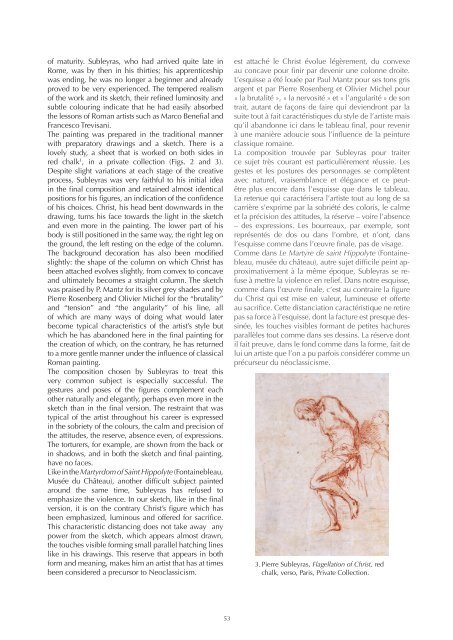XVII - Master Paintings - Jean Luc Baroni and Marty de Cambiaire
Create successful ePaper yourself
Turn your PDF publications into a flip-book with our unique Google optimized e-Paper software.
of maturity. Subleyras, who had arrived quite late in<br />
Rome, was by then in his thirties; his apprenticeship<br />
was ending, he was no longer a beginner <strong>and</strong> already<br />
proved to be very experienced. The tempered realism<br />
of the work <strong>and</strong> its sketch, their refined luminosity <strong>and</strong><br />
subtle colouring indicate that he had easily absorbed<br />
the lessons of Roman artists such as Marco Benefial <strong>and</strong><br />
Francesco Trevisani.<br />
The painting was prepared in the traditional manner<br />
with preparatory drawings <strong>and</strong> a sketch. There is a<br />
lovely study, a sheet that is worked on both si<strong>de</strong>s in<br />
red chalk 1 , in a private collection (Figs. 2 <strong>and</strong> 3).<br />
Despite slight variations at each stage of the creative<br />
process, Subleyras was very faithful to his initial i<strong>de</strong>a<br />
in the final composition <strong>and</strong> retained almost i<strong>de</strong>ntical<br />
positions for his figures, an indication of the confi<strong>de</strong>nce<br />
of his choices. Christ, his head bent downwards in the<br />
drawing, turns his face towards the light in the sketch<br />
<strong>and</strong> even more in the painting. The lower part of his<br />
body is still positioned in the same way, the right leg on<br />
the ground, the left resting on the edge of the column.<br />
The background <strong>de</strong>coration has also been modified<br />
slightly: the shape of the column on which Christ has<br />
been attached evolves slightly, from convex to concave<br />
<strong>and</strong> ultimately becomes a straight column. The sketch<br />
was praised by P. Mantz for its silver grey sha<strong>de</strong>s <strong>and</strong> by<br />
Pierre Rosenberg <strong>and</strong> Olivier Michel for the “brutality”<br />
<strong>and</strong> “tension” <strong>and</strong> “the angularity” of his line, all<br />
of which are many ways of doing what would later<br />
become typical characteristics of the artist’s style but<br />
which he has ab<strong>and</strong>oned here in the final painting for<br />
the creation of which, on the contrary, he has returned<br />
to a more gentle manner un<strong>de</strong>r the influence of classical<br />
Roman painting.<br />
The composition chosen by Subleyras to treat this<br />
very common subject is especially successful. The<br />
gestures <strong>and</strong> poses of the figures complement each<br />
other naturally <strong>and</strong> elegantly, perhaps even more in the<br />
sketch than in the final version. The restraint that was<br />
typical of the artist throughout his career is expressed<br />
in the sobriety of the colours, the calm <strong>and</strong> precision of<br />
the attitu<strong>de</strong>s, the reserve, absence even, of expressions.<br />
The torturers, for example, are shown from the back or<br />
in shadows, <strong>and</strong> in both the sketch <strong>and</strong> final painting,<br />
have no faces.<br />
Like in the <strong>Marty</strong>rdom of Saint Hippolyte (Fontainebleau,<br />
Musée du Château), another difficult subject painted<br />
around the same time, Subleyras has refused to<br />
emphasize the violence. In our sketch, like in the final<br />
version, it is on the contrary Christ’s figure which has<br />
been emphasized, luminous <strong>and</strong> offered for sacrifice.<br />
This characteristic distancing does not take away any<br />
power from the sketch, which appears almost drawn,<br />
the touches visible forming small parallel hatching lines<br />
like in his drawings. This reserve that appears in both<br />
form <strong>and</strong> meaning, makes him an artist that has at times<br />
been consi<strong>de</strong>red a precursor to Neoclassicism.<br />
est attaché le Christ évolue légèrement, du convexe<br />
au concave pour finir par <strong>de</strong>venir une colonne droite.<br />
L’esquisse a été louée par Paul Mantz pour ses tons gris<br />
argent et par Pierre Rosenberg et Olivier Michel pour<br />
« la brutalité », « la nervosité » et « l’angularité » <strong>de</strong> son<br />
trait, autant <strong>de</strong> façons <strong>de</strong> faire qui <strong>de</strong>viendront par la<br />
suite tout à fait caractéristiques du style <strong>de</strong> l’artiste mais<br />
qu’il ab<strong>and</strong>onne ici dans le tableau final, pour revenir<br />
à une manière adoucie sous l’influence <strong>de</strong> la peinture<br />
classique romaine.<br />
La composition trouvée par Subleyras pour traiter<br />
ce sujet très courant est particulièrement réussie. Les<br />
gestes et les postures <strong>de</strong>s personnages se complètent<br />
avec naturel, vraisemblance et élégance et ce peutêtre<br />
plus encore dans l’esquisse que dans le tableau.<br />
La retenue qui caractérisera l’artiste tout au long <strong>de</strong> sa<br />
carrière s’exprime par la sobriété <strong>de</strong>s coloris, le calme<br />
et la précision <strong>de</strong>s attitu<strong>de</strong>s, la réserve – voire l’absence<br />
– <strong>de</strong>s expressions. Les bourreaux, par exemple, sont<br />
représentés <strong>de</strong> dos ou dans l’ombre, et n’ont, dans<br />
l’esquisse comme dans l’œuvre finale, pas <strong>de</strong> visage.<br />
Comme dans Le <strong>Marty</strong>re <strong>de</strong> saint Hippolyte (Fontainebleau,<br />
musée du château), autre sujet difficile peint approximativement<br />
à la même époque, Subleyras se refuse<br />
à mettre la violence en relief. Dans notre esquisse,<br />
comme dans l’œuvre finale, c’est au contraire la figure<br />
du Christ qui est mise en valeur, lumineuse et offerte<br />
au sacrifice. Cette distanciation caractéristique ne retire<br />
pas sa force à l’esquisse, dont la facture est presque <strong>de</strong>ssinée,<br />
les touches visibles formant <strong>de</strong> petites hachures<br />
parallèles tout comme dans ses <strong>de</strong>ssins. La réserve dont<br />
il fait preuve, dans le fond comme dans la forme, fait <strong>de</strong><br />
lui un artiste que l’on a pu parfois considérer comme un<br />
précurseur du néoclassicisme.<br />
3. Pierre Subleyras, Flagellation of Christ, red<br />
chalk, verso, Paris, Private Collection.<br />
53















